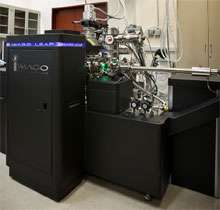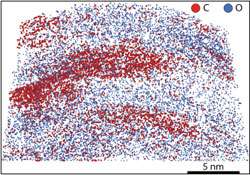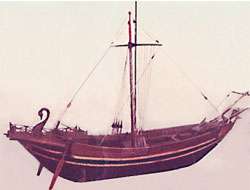Glass from the past informs decisions for the future

A new investment at the Department of Energy’s EMSL is now being used in an international effort to study 1,800-year-old pieces of glass from a Roman shipwreck and ruin. The primary goal of the research is not archaeological; scientists are looking thousands of years into the future to assess the safe disposal of radioactive waste in glass.
The local electrode atom probe – a $1.6 million atom probe tomography system referred to as “LEAP” – is enabling EMSL users Denis Strachan and Joseph Ryan, both with Pacific Northwest National Laboratory, to obtain atom-by-atom views of how glass corrodes over time.
Located at EMSL, LEAP was purchased with American Recovery and Reinvestment Act funds. It’s the first analytical tool of its kind available to the global scientific community in a user facility. LEAP offers unprecedented 3-D chemical imaging of metals, and it’s currently being developed to analyze low electrical conductivity materials, such as ceramics, semiconductors and oxides. Discovering the most fundamental properties of these materials can lead to new technological innovations.
NOW AND LATER
Scientists use LEAP for a wide variety of experiments. In this case it is directly related to an environmental cleanup mission at the Department of Energy’s Hanford Nuclear Reservation near PNNL.
At Hanford, the DOE is building an immense facility devoted to vitrification – the process of containing radioactive waste by transforming it into highly durable glass for long-term storage. To support safety both for present and future generations, scientists like Strachan, Ryan and other top researchers worldwide are using sophisticated instruments and computer models to help understand how glass will behave over the long term, up to 1 million years.

Glass dissolves very slowly, which is a major reason it’s being used to store radioactive waste. However, this advantage also presents a challenge. It’s difficult to perform experiments over sufficiently long periods to gather the results scientists need to refine the computer simulations used to calculate the behavior of vitrified waste stability over thousands of years.
Studying how glass dissolves requires sophisticated instrumentation and ancient glass. The longest test on a piece of human-made, simulated nuclear-waste glass has been about 25 years. So Strachan and Ryan sought out collaboration with EMSL and Italian scientists to analyze Roman glass artifacts collected recently in Italy. Modern technology created advanced capabilities, such as LEAP, to effectively investigate these artifacts.

THE ILL-FATED IULIA FELIX
One source of the ancient glass was the Iulia Felix, a common merchant ship called a corbita that shipwrecked in the northern Adriatic Sea in the second or third century AD. The roughly 50-foot-long ship was carrying a barrel containing about 11,000 pieces, or about 309 pounds, of glass for recycling and containers holding oils and spices. Early in 2011, the PNNL team worked with the University of Padua in Italy to obtain samples of glass recovered from the Iulia Felix. They also recovered glass still in contact with soil from an 1,800-year-old Roman villa in the nearby town of Aquileia. In addition, they are collaborating with French scientists to study a third glass sample of about the same age from a shipwreck off the southern coast of France, near the island of Embiez.
At EMSL, the researchers are using LEAP and focused ion beam sample preparation techniques to give them the experimental data needed to properly interpret the results of these 1,800-year-long experiments. With the first round of experiments, unforeseen findings have already surfaced related to the glass structure and durability.
“Our very first analyses showed previously undetected nanoscale segregation of magnesium into layers that are roughly two nanometers thick,” said Ryan. “We expect to find even more surprises as we continue to interpret the data in more detail.”
Detailed data like these, drawn from an experiment nearly 2,000 years in the making, are then integrated with computational models to improve simulations of glass dissolution. The techniques used in these studies are already being applied to corroded simulated waste glasses to allow precise comparisons between the different types of glass. Further results will allow engineers to use the incredible durability of vitrified waste with confidence when designing repositories.
As a byproduct of this research, archaeologists will also benefit by having more information about how glasses interact with water.
Provided by Environmental Molecular Sciences Laboratory





















